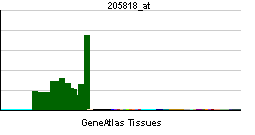DBC1
| Deleted in bladder cancer 1 | |||||||||||
|---|---|---|---|---|---|---|---|---|---|---|---|
| Identifiers | |||||||||||
| Symbols | DBC1 ; DBCCR1; FAM5A | ||||||||||
| External IDs | Template:OMIM5 Template:MGI HomoloGene: 8754 | ||||||||||
| |||||||||||
| RNA expression pattern | |||||||||||
 | |||||||||||
| More reference expression data | |||||||||||
| Orthologs | |||||||||||
| Template:GNF Ortholog box | |||||||||||
| Species | Human | Mouse | |||||||||
| Entrez | n/a | n/a | |||||||||
| Ensembl | n/a | n/a | |||||||||
| UniProt | n/a | n/a | |||||||||
| RefSeq (mRNA) | n/a | n/a | |||||||||
| RefSeq (protein) | n/a | n/a | |||||||||
| Location (UCSC) | n/a | n/a | |||||||||
| PubMed search | n/a | n/a | |||||||||
Deleted in bladder cancer 1, also known as DBC1, is a human gene.[1]
This gene is located within a chromosomal region that shows loss of heterozygosity in some bladder cancers. It contains a 5' CpG island that may be a frequent target of hypermethylation, and it may undergo hypermethylation-based silencing in some bladder cancers.[1]
References
Further reading
- Auffray C, Behar G, Bois F; et al. (1995). "[IMAGE: molecular integration of the analysis of the human genome and its expression]". C. R. Acad. Sci. III, Sci. Vie. 318 (2): 263–72. PMID 7757816.
- Habuchi T, Yoshida O, Knowles MA (1997). "A novel candidate tumour suppressor locus at 9q32-33 in bladder cancer: localization of the candidate region within a single 840 kb YAC". Hum. Mol. Genet. 6 (6): 913–9. PMID 9175739.
- Habuchi T, Luscombe M, Elder PA, Knowles MA (1998). "Structure and methylation-based silencing of a gene (DBCCR1) within a candidate bladder cancer tumor suppressor region at 9q32-q33". Genomics. 48 (3): 277–88. doi:10.1006/geno.1997.5165. PMID 9545632.
- Nishiyama H, Hornigold N, Davies AM, Knowles MA (1999). "A sequence-ready 840-kb PAC contig spanning the candidate tumor suppressor locus DBC1 on human chromosome 9q32-q33". Genomics. 59 (3): 335–8. doi:10.1006/geno.1999.5891. PMID 10444335.
- Nishiyama H, Takahashi T, Kakehi Y; et al. (2000). "Homozygous deletion at the 9q32-33 candidate tumor suppressor locus in primary human bladder cancer". Genes Chromosomes Cancer. 26 (2): 171–5. PMID 10469456.
- Nishiyama H, Gill JH, Pitt E; et al. (2001). "Negative regulation of G(1)/S transition by the candidate bladder tumour suppressor gene DBCCR1". Oncogene. 20 (23): 2956–64. doi:10.1038/sj.onc.1204432. PMID 11420708.
- Wright KO, Messing EM, Reeder JE (2002). "Increased expression of the acid sphingomyelinase-like protein ASML3a in bladder tumors". J. Urol. 168 (6): 2645–9. doi:10.1097/01.ju.0000037848.19383.88. PMID 12442002.
- Strausberg RL, Feingold EA, Grouse LH; et al. (2003). "Generation and initial analysis of more than 15,000 full-length human and mouse cDNA sequences". Proc. Natl. Acad. Sci. U.S.A. 99 (26): 16899–903. doi:10.1073/pnas.242603899. PMID 12477932.
- Wright KO, Messing EM, Reeder JE (2004). "DBCCR1 mediates death in cultured bladder tumor cells". Oncogene. 23 (1): 82–90. doi:10.1038/sj.onc.1206642. PMID 14712213.
- Humphray SJ, Oliver K, Hunt AR; et al. (2004). "DNA sequence and analysis of human chromosome 9". Nature. 429 (6990): 369–74. doi:10.1038/nature02465. PMID 15164053.
- Gerhard DS, Wagner L, Feingold EA; et al. (2004). "The status, quality, and expansion of the NIH full-length cDNA project: the Mammalian Gene Collection (MGC)". Genome Res. 14 (10B): 2121–7. doi:10.1101/gr.2596504. PMID 15489334.
- Beetz C, Brodoehl S, Patt S; et al. (2005). "Low expression but infrequent genomic loss of the putative tumour suppressor DBCCR1 in astrocytoma". Oncol. Rep. 13 (2): 335–40. PMID 15643521.
- Izumi H, Inoue J, Yokoi S; et al. (2005). "Frequent silencing of DBC1 is by genetic or epigenetic mechanisms in non-small cell lung cancers". Hum. Mol. Genet. 14 (8): 997–1007. doi:10.1093/hmg/ddi092. PMID 15746151.
- Rual JF, Venkatesan K, Hao T; et al. (2005). "Towards a proteome-scale map of the human protein-protein interaction network". Nature. 437 (7062): 1173–8. doi:10.1038/nature04209. PMID 16189514.
- Louhelainen JP, Hurst CD, Pitt E; et al. (2006). "DBC1 re-expression alters the expression of multiple components of the plasminogen pathway". Oncogene. 25 (16): 2409–19. doi:10.1038/sj.onc.1209228. PMID 16369496.
| This protein-related article is a stub. You can help Wikipedia by expanding it. |